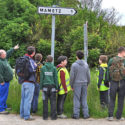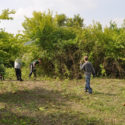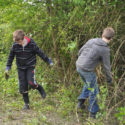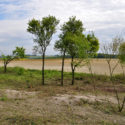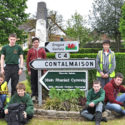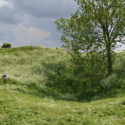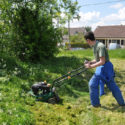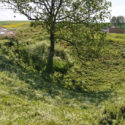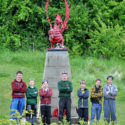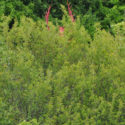It wasn’t always like this.
When Capt Mervyn Jones, Platoon Commander, Rossett Platoon, Clwyd and Gwynedd Army Cadet Force first took his Cadets to the Somme in 2006 he could never have envisaged becoming involved in vital site clearance work.
The Lochnagar Crater was an obvious site for the Cadets to parade. The Crater is the result of a massive detonation within a tunnel dug beneath German lines, designed to create devastation and confusion as the first wave of troops went “over the top”. There are a number of ceremonies of remembrance on the 1st of July each year but there is an extra poignancy to a parade held at 07.30, the exact time that the battle began. The emotions stirred by linking arms around the perimeter of a crater, which is still 80 feet deep and a sixth of a mile in circumference, are difficult to describe.
The request for assistance made by Sir Richard Dunning and the Friends of the Crater, in terms of help to control the trees and scrub around the perimeter, came out of the blue. Cadets, however, are always happy to help. Unfortunately, youthful enthusiasm does not always overcome hopeless naivete. Hawthorn and wild rose are worthy adversaries that will contemptuously chew up equipment designed for domestic garden use. Whilst the Cadets were able to punch a five yard wide hole in the perimeter the maths did not add up with a sixth of a mile perimeter to tidy before the 100th anniversary in 2016.
Consequently, in 2012, with very generous support from the Ulysses Trust, newly recruited civilian assistance and tools fit for purpose, Rossett Platoon deployed on Lochnagar Dragon I, an extremely successful additional trip to the Somme. Good work though seldom goes unnoticed and it wasn`t long before further requests for assistance were being received.
Only a short distance from the crater lies a patch of land known as the “Glory Hole”, a part of the British front line surrounded on 3 sides by German positions occupying higher ground. The land is almost unique in that it lies untouched since fighting finished. It is now the site of a major archaeological project which has accessed a series of military tunnels and has been the subject of a recent BBC documentary. The land, being heavily crater scarred, needed strimming.
Most poignantly for the Cadets however was the work needing to be done at the Mametz Memorial commemorating the men of the 38th (Welsh Division) which sustained over 4,000 casualties in Mametz Wood during the early stages of the Somme offensive. The view from the Memorial across the farmland to Mametz Wood, the German frontline, had become obscured.
With ongoing generous support from the Ulysses Trust, Ex Lochnagar Dragon II deployed on 23 May 2013 for a very intensive 5 days of hard labouring. Despite awful weather on the first two days the determination and cheerfulness of the Cadets never wavered and all 3 objectives were achieved.
It is always fascinating to observe how young people develop during these exercises. Newly appointed Cadet Sergeant Major Ceiron Edwards appreciating the value of stepping back to hone his command and control skills. Cadet Cpl Michael Barnes, a representative of the so called playstation generation, absorbed in mechanical engineering conundrums when the tools were dissembled for maintenance and young Cadet Sam Moth forfeitiing his break and demonstrating commendable determination to attack, fell and remove a dead but still standing mature tree. All the Cadets embraced the challenge of sleeping under canvas, a march into the days location and extremely hard work to learn they can survive, thrive and achieve in a somewhat unfamiliar outdoor environment, even in poor weather.
With the weather poor for the first two days it was a struggle to get the cadets motivated enough to cover the 12km route at the start of each day and even more hard at the end when everyone was tired, but the thought of the work done and the opportunity to hone in their map and compass skills and pack-carrying helped them along or could it have been the thought of a warm shower before preparing their evening meal at the campsite and then getting their heads down in their tents for the night that kept them on track, or just the thought that they were achieving things they never throught they could do. The help of the Ulysses Trust certainly helped make the Exercise a success and we cannot thank them enough for their support to this Exercise.
It is impossible to underestimate the Cadet`s achievements. Each of these sites are representative of the ultimate sacrifice of thousands of our forebears in the service of their country. It is imperative that these sites are tidy and in good order for the forthcoming 100th anniversary commemorations. However, it is something more than that. Each of these sites, on their own, can evoke the strongest of emotions. But nothing, in a war of this magnitude, occurred in isolation. Everything happened in a much wider context and, for the visitor, a wall of impenetrable hawthorn destroys that context. In every sense the Cadets can be proud of their work.
With a little more of the Lochnagar Crater perimeter still to be tackled and potentially more work in the pipeline, the Cadets await the challenges of 2014.
Capt Mervyn Jones, Platoon Commader, Rossett Platoon

